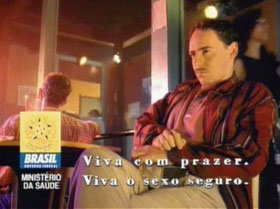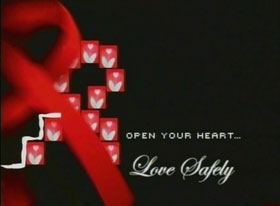A couple kiss on the stairs – the caption “to embrace” slides across the TV screen. An expectant mother tenderly touches her stomach – the text “to love” appears over the image. Women, men, boys, girls, friends, lovers, families – all depicted in a 30-second TV spot to underline messages on AIDS to encourage viewers to “always protect yourself and those you love”.
This awareness-raising public service announcement from Argentina produced in 2004 is just one of nearly 200 television spots that have been brought together in a special 10-year anthology DVD of televised public service announcements about HIV from the Americas region produced by the Pan American Health Organization (PAHO).
The two-disc set, entitled “VIHdeo America”, presents spots produced from 1995-2005 and intends to share information, history and experiences about the use of TV for HIV campaigns to help encourage new approaches to AIDS communications.
From Argentina to Venezuela, Chile to Uruguay, the compilation contains examples from 24 countries, and is directed primarily at people involved in communicating about AIDS. In the special fact sheet accompanying the DVDs, the producers underline their hopes that the compilation will help communicators working across the region analyze and evaluate the work that has been produced over the last ten years, to better inform future campaigns using television media.

“In our region, countries develop mass media campaigns against HIV almost every year. Posters and brochures sometimes circulate, but TV spots seldom cross the national boundaries, as TV tends to broadcast only within the national territory. Neighbouring countries often have no idea of what other countries have developed for TV. “VIHdeo America” helps to break this silence,” said Paulo Lyra from PAHO who was involved in the production of the DVD. “TV is a particularly expensive media, particularly in countries that pay for air time. This makes it imperative to learn about how to best use this media for future communications on AIDS,” he added.
VIHdeo America’s producers underline that the anthology is not intended as a ‘showcase’ of best practices, moreover, they stress that critical analysis of the slots, particularly some of those produced in the early years of the anthology, is absolutely necessary to ensure televised public service announcements on HIV are doing good, not harm.
“As much as it can have a positive effect, we know that communication can also fuel stigma and discrimination. For instance, some of the older spots contain “fear appeals” or appear to blame “vulnerable groups”. What we need to do is to ask ourselves critically if the newer spots have broken with that tradition and building on these experiences, how can we ensure future spots are breaking down discrimination and reaching the people who need them most,” Lyra said.
With titles such as ‘Love Safely’, ‘Welcome to Condom County’ and ‘Know AIDS-NO AIDS’ the clips included in the anthology portray an extremely wide variety of scenarios and situations. All clips have subtitles in English and Spanish. Some are serious in tone, some use humour to get the message across. “ Brazil, for instance, produced a series, “Braulio” about a man speaking to his penis which is hilarious. This happened in 1995 and was quite revolutionary at the time. But they did it and it’s an example of how AIDS communicators can expand their horizons,” said Lyra.
“Communications can be a powerful tool in the AIDS response. Analysis of what has and hasn’t worked over the last years can help communicators find bigger and better ways to get the right messages across,” said UNAIDS’ Head of Public Affairs and Communication, Annemarie Hou.
“VIHdeo America” is available for order through the Pan American Health Organization. For more information, visit www.paho.org/vihdeoamerica.
All photo credits: vihdeoamericas/PAHO







